- What it’s
- When practice
- Step-by-step guide
- Chandra vs. Surya Namaskar
- Precautions
- Contraindications
- Beginners Tips
- Modifications
- Benefits
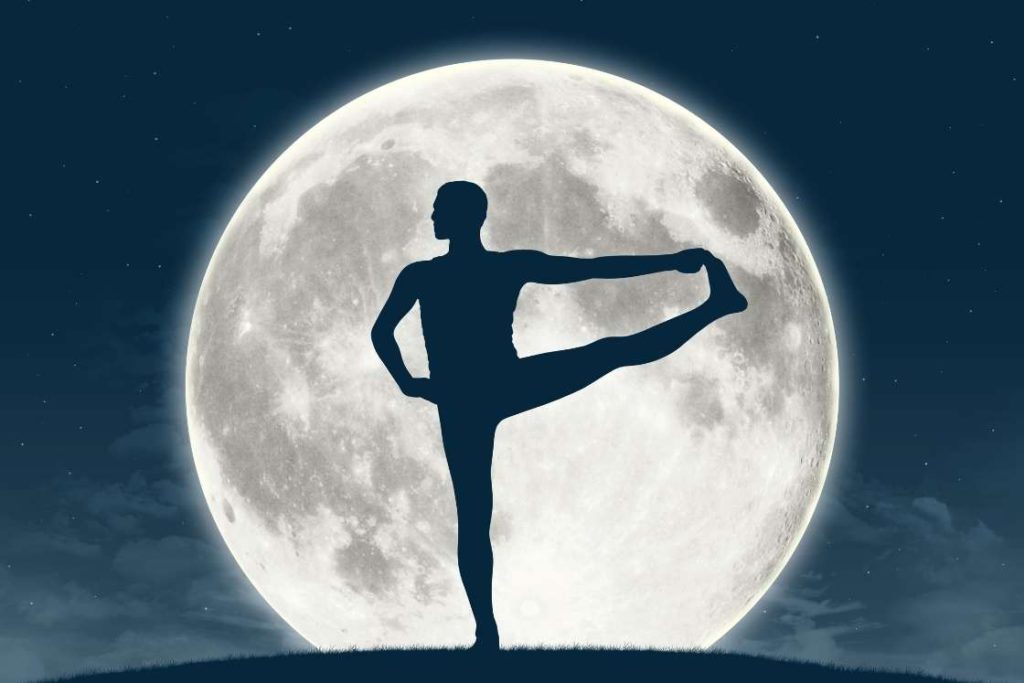
Sun and Moon represent two opposing forces of nature i.e. solar and lunar energies. According to hatha yoga, these two forces also resides within us in the form of Ida and Pingala Nadi.
Just like the sun salutation is practiced to emulate the warm, active, and energizing qualities, moon salutation is practiced to bring the cooling and quieting effect in the body.
What is Moon Salutation (Chandra Namaskar)?
Moon salutation, also known as Chandra Namaskar (CHAHN-drah nah-muh-SKAR-uh) in Sanskrit, is a cooling sequence of 14 yoga poses. In this sequence, practitioners bow down for the moon to find calm, peace, and light in their life.
In yoga, ‘Chandra’ or ‘Moon’ is concerned with the feminine aspects of the practitioner. It allows the relocation of the hidden subtle insight, emotions, desires, and self-belief from the bottom to the surface of the inner self. ‘Moon’ has a light, cool and feminine persona, which is the reason it awakens the soft side in the practitioners.
Chandra Namaskar sequence is practiced in the evening hours when the moon is visible. It’s most beneficial for people who usually have pain & stiffness in the lower limbs.
Why we should practice Chandra Namaskara?
There is no doubt in admitting that physical movements have somehow impacted our natural health. In case, If those movements are associated with Yoga, then it definitely gonna offer some amazing results.
Chandra Namaskar is a set of poses when practiced, It organizes our chaotic or disturbed state of mind and body in a balanced way. To achieve this, one should follow the sequence of specific asanas with the right pattern of breathing along with a particular time period.
This initiates a process from the cellular level to the organ and then spiritual. It carves a healthy human from a normal one. The practice not only looks after the body but also raise the awareness with which a person can connect more through his/her surrounding. Hence, in this way, Chandra Namaskara works on various approaches that ease life and living.
When To Practice Chandra Namaskar?
As it’s a cooling sequence, Chandra Namaskar is often practiced at the end of a yoga session, end of the day in the evening, or night as bedtime yoga practice.
Moreover, on moon phases like the ‘full moon’ or ‘new moon’ [efn_note] Phases of the Moon https://simple.wikipedia.org/wiki/Phases_of_the_Moon [/efn_note], practicing Chandra Namaskar can help release too much “Apana,” the life force of elimination. An overabundance of Apana can create too much heaviness in the body.
Chandra Namaskar (Moon Salutation) Step-by-Step Guide
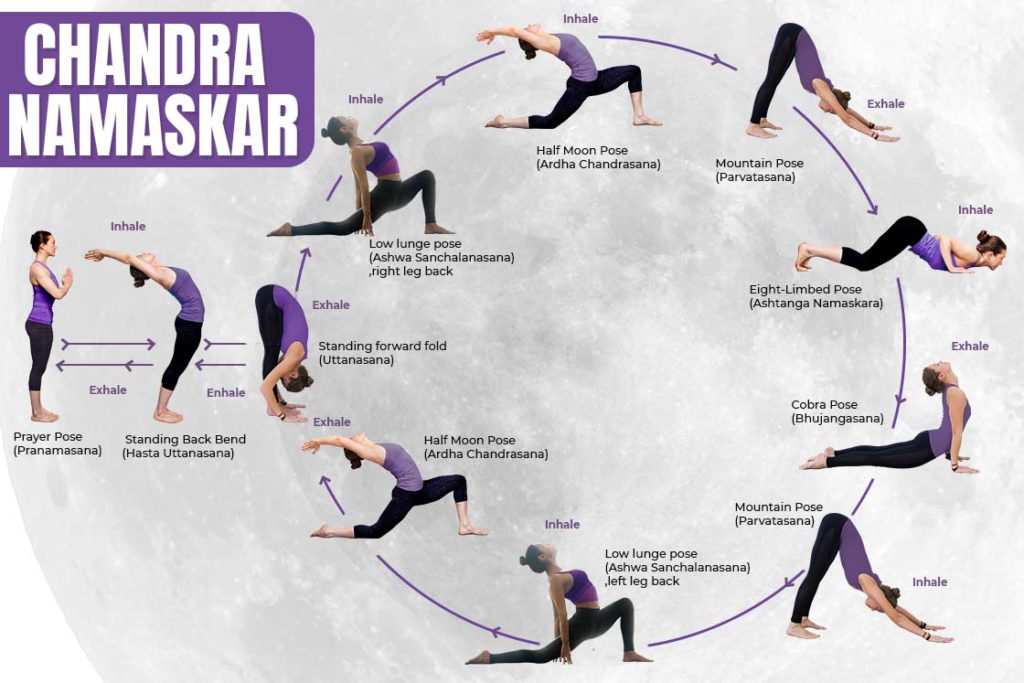
Stand in front of your mat in tadasana; feet together, hands by the sides, and breath gently. Take some time to find a steady breath pace and be aware of your body movements;
Start chandra namaskar with;
1. Prayer Pose (Pranamasana)
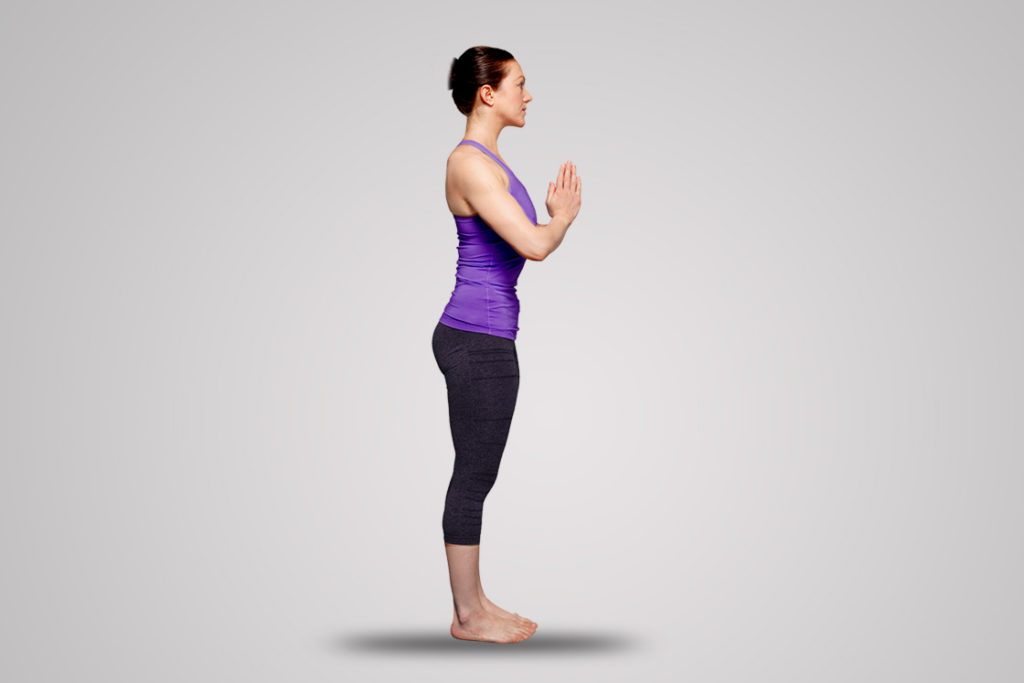
- Stand upright bringing the feet together and arms by your sides.
- Slowly bend your elbows to join your palms in Anjali Mudra in front of the chest.
- Close your eyes, relax the entire body, and keep breathing normally.
2. Raised arms pose (Hastauttanasana)
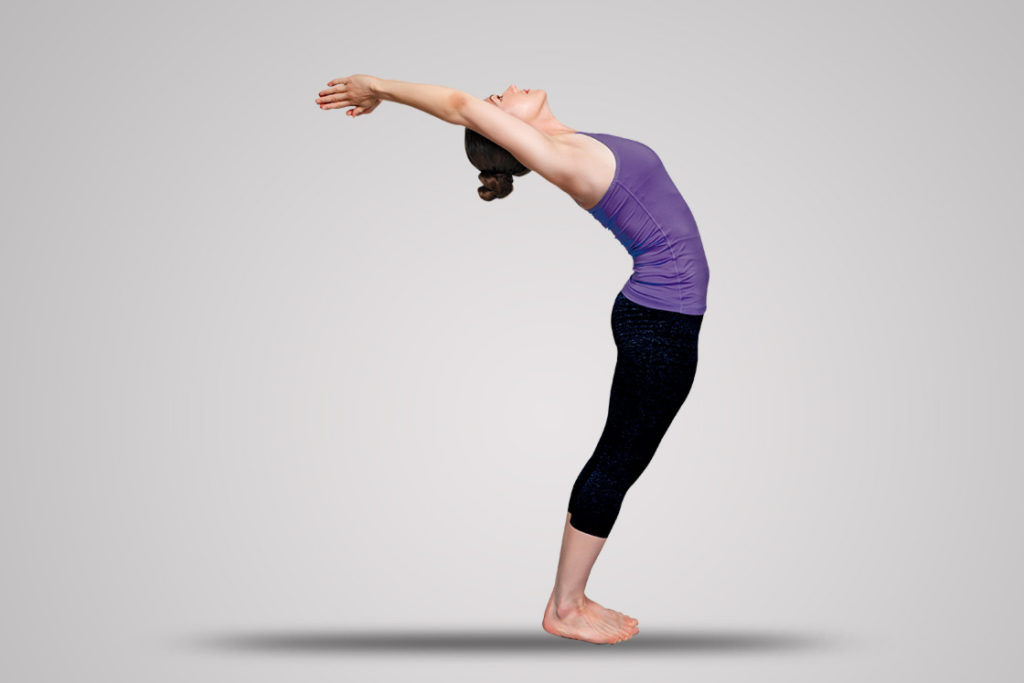
- Raise your hand with an inhale, and then bend back by bringing an arch in your spine. Try to take your hand as high as possible.
- Arching your spine push your pelvis to the front. Both balance each other.
- Your knees and elbows should be straight, chin facing the ceiling and head between the hand.
3. Hand to foot pose (Padahastasana)
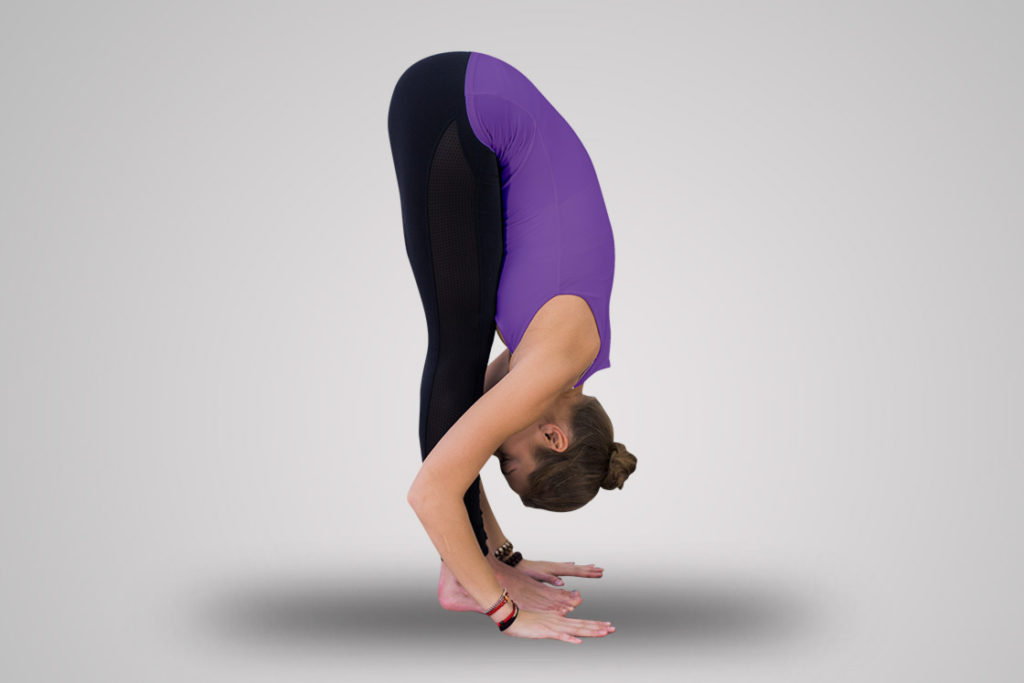
- Exhale and bring your body back into an upright position. Your hand still remain straight and parallel to each other.
- Now, bend forward and place your hand beside either of the feet. Try to touch your shin bone with your forehead.
- Keep your knees straight and avoid curves in your spine by touching the chest on your thighs.
4. Equestrian pose (Ashwa Sanchalanasana)
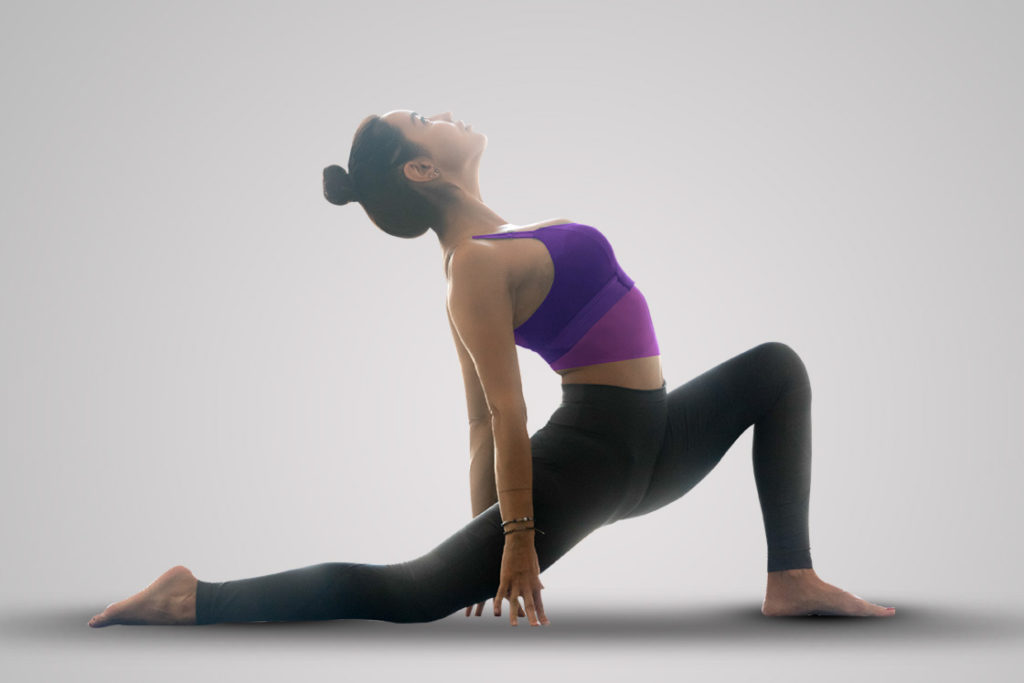
- From Padahastasana inhale to proceed into Ashwa Sanchalasana, Take your right leg back as far as possible and the sole of the feet should be facing the ceiling.
- Roll up your shoulder to open the chest and gaze toward the ceiling side simultaneously touch the floor with the fingers.
- All the three, your both hand and left leg are aligned in a straight line under the shoulder.
5. Half Moon Pose (Ardha Chandrasana)
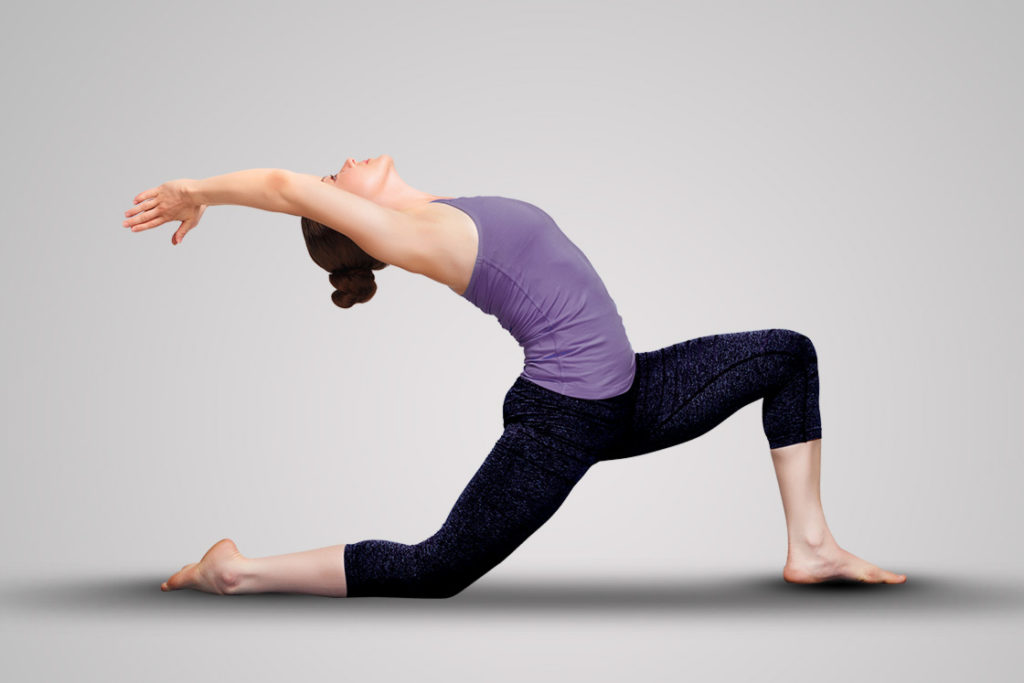
- In here, bending your left leg and take your pelvis a little deeper than in an Ashwa Sanchalasana. It will shift your right leg farther behind the body.
- Your right foot’s toe remains tucked on the floor. Now, inhale roll your shoulder behind so you can stretch your hand farther. This will Open up your chest. Now, fix your gaze to the ceiling.
6. Mountain Pose (Parvatasana)
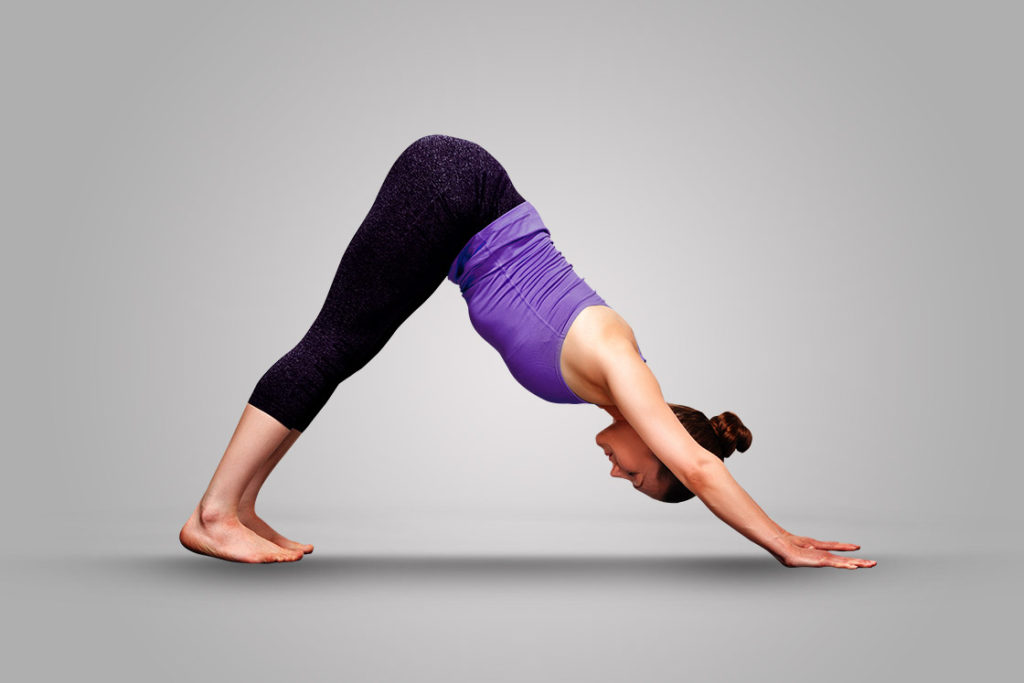
- Now exhale to bring your palms on the floor and place your left foot beside your right foot as well by lifting your hips up.
- Lengthen your spine, locks your shoulder blade. Straighten your legs by engaging your thigh and gluts muscles.
- Your head in between your hand gazing toward your foot. Make a perfect V shape by your body here.
Parvatasana is similar to downward-facing dog expect feet remain together.
7. Eight Limb Pose (Ashtanga Namaskar)
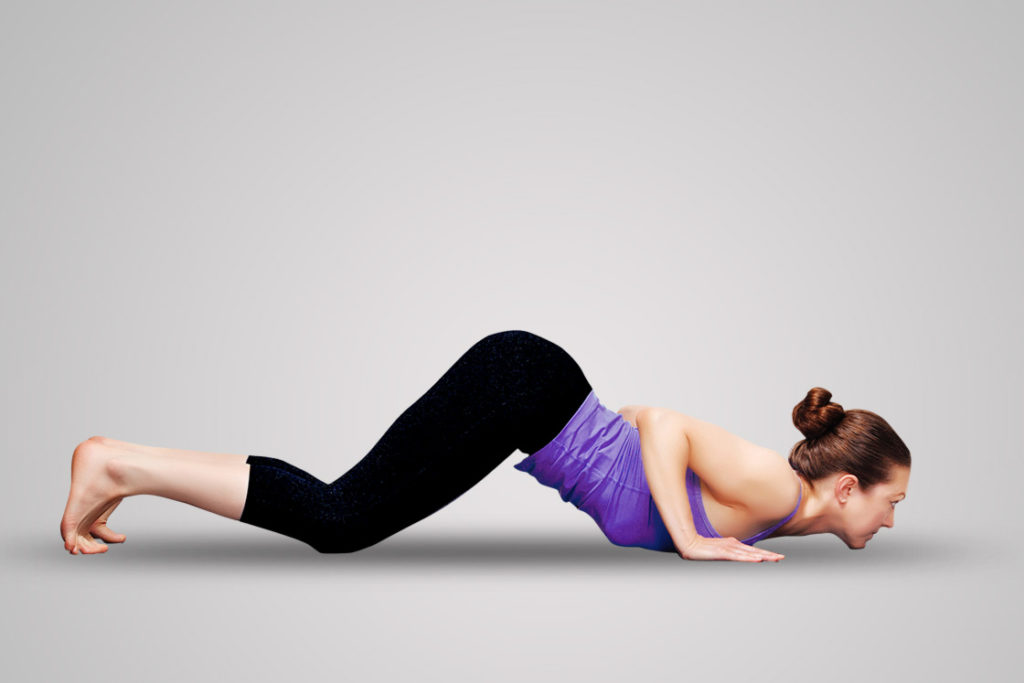
- With another exhale, lower your pelvis and try to touch your knees, chest, and either chin or forehead on the floor.
- Make sure that feet remain tucked in this pose and palms beside your chest. Hold your breath outside here.
8. Cobra pose (Bhujangasana)
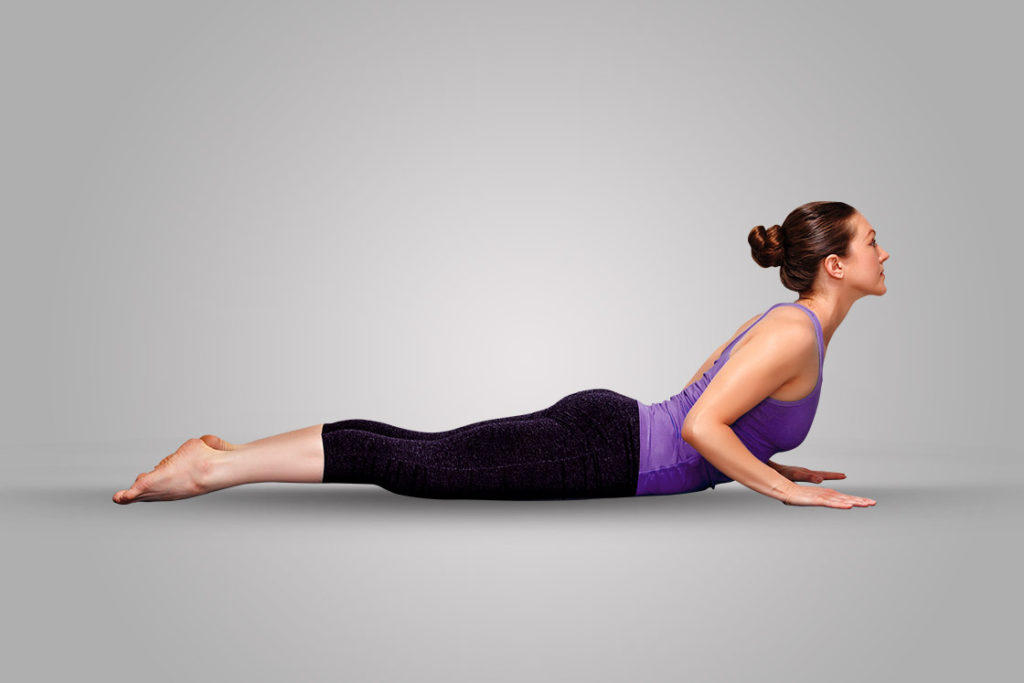
- Now, inhale slide forward to raise your chest upward, and form a concave curve in your spine.
- The sole of your feet facing the ceiling, palm remain still and look up to widen your chest.
9. Mountain Pose (Parvatasana)
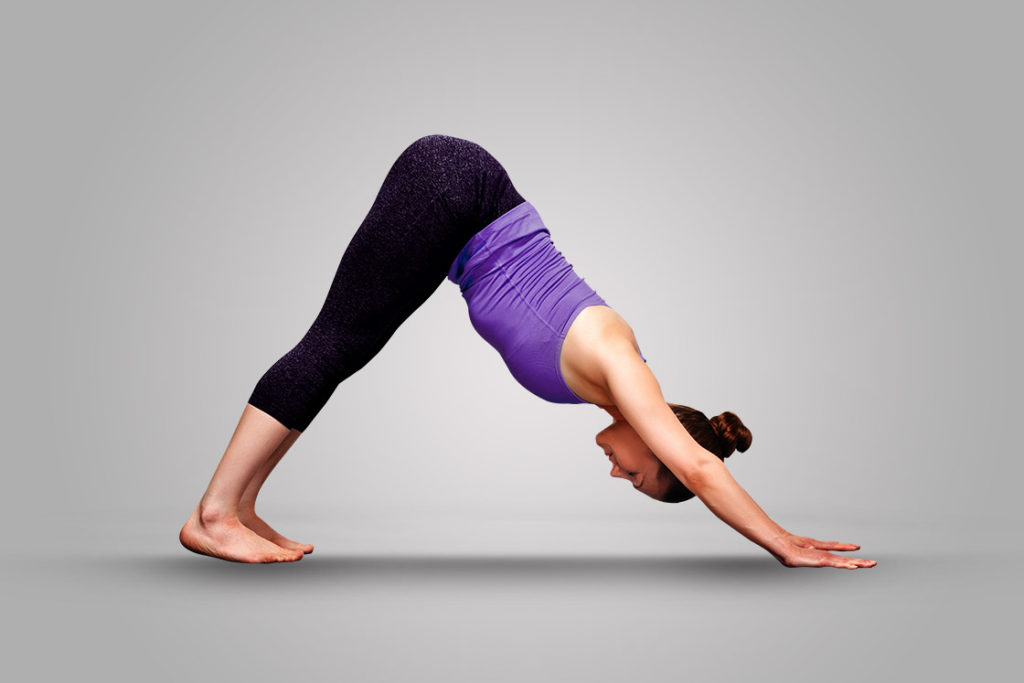
- Exhale to press the floor through your palm to raise your pelvis a bit more and gradually lift your knees, chest, chin, or forehead up.
- Lengthen your spine to straighten your back along with a straight hand and legs. place your foot flat on the floor.
10. Equestrian pose (Ashwa Sanchalanasana)

- Now, bring the alternate (right) foot forward in between your hand and let the left foot remain behind as you inhale.
- Raise your torso and bring a slight curve in your spine to look upside and Maintain here for some time
11. Half Moon Pose (Ardha Chandrasana)

- Raise your hand up while inhalation and then back over the head by developing an arch in the spine.
- Maintain a shoulder-width distance between the hand and Look upside, in a manner your chin faces upside.
12. Hand to foot pose (Padahastasana)

- Exhale to bring your left foot back beside the right one and straighten the knees and backbend in a forwarding direction.
- Your forehead touching your shin and chest rubbing against your thighs. Hand beside the either of the side.
13. Raised arms pose (Hastauttanasana)

- Now, inhale and raise your arms up as transition from a backbend into the Standing position.
- Arch backward by giving an inward curve in the spine. Your feet remain together, knees straight and gaze to the ceiling side.
14. Prayer Pose (Pranamasana)

- Bring back your torso in the middle position and drop your hand to make Namaste mudra or Pranamasana here.
- Look straight, shoulder align and body should be stabilized on both the feet. Breathe here for some time and then relax.
Chandra Namaskar vs. Surya Namaskar
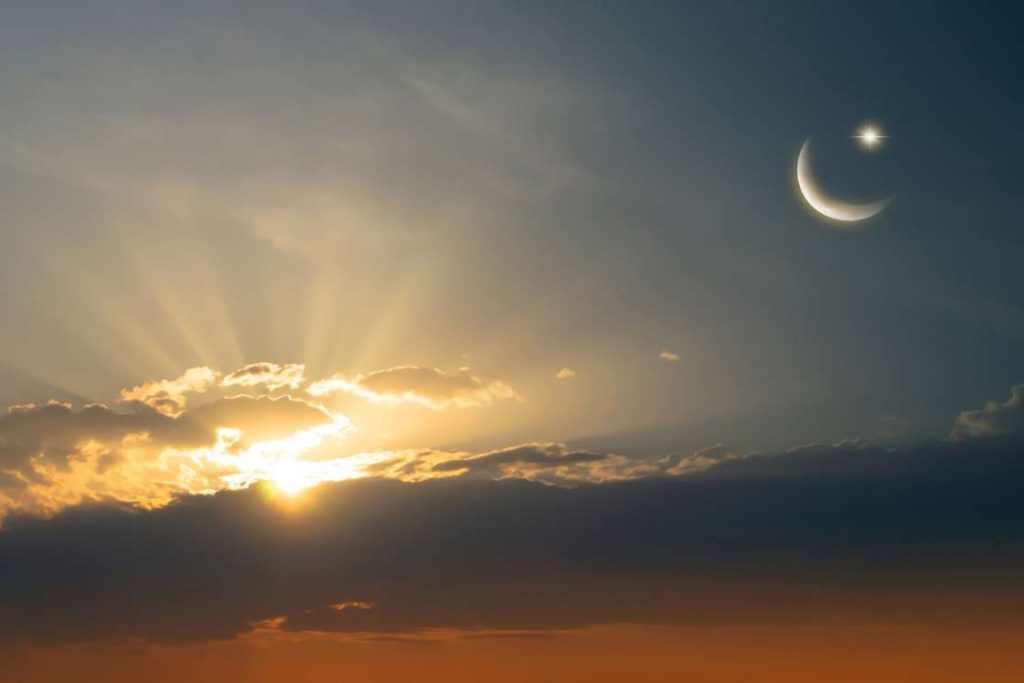
It is quite interesting to know that both salutation practices are almost similar to one another but there is a slight difference from certain points of view.
Chandra Namaskara represents the moon which further contributes to calmness, peace, and serenity. However, the moon is interlinked with water in a cosmic way [efn_note] The cosmic deep blue: The significance of the celestial water world sphere across cultures https://www.researchgate.net/publication/279092781_The_cosmic_deep_blue [/efn_note]. The way the gravitational pull of the moon causes tides on earth containing water in abundance, Chandra Namaskar interacts with our body whose most of part is water. In this way, the water element, which is one of the five fundamental elements of the body, due to its presence in each and every cell of the body brings profoundness on a physical, mental and spiritual level.
Whereas, Surya Namaskara is determined by masculinity, charisma, heat, and valor of spirit. Being the only source of energy on earth it nourishes lives and in doing so, it plays a role of a parent or guardian. In Hinduism, the sun is believed to be the deity, which governs various aspects of human life from Astrology to the Biology of the body. The salutation is a practice of paying a tribute or respect to the sun playing the role of god, energy giver, teacher, and the almighty of the solar system.
Time of Practice
Chandra Namaskara is usually performed in the evening to ensure the calming effect in abundance on our body, which induces sound sleep and relaxes thoroughly.
Surya Nmaskara is believed to be practiced basically in the Brahma Muhurta of Early morning. It fills the practitioner with energy, heat that helps in tackling obstacles throughout the day.
The poses
The 14 poses of the Chandra Namaskar represent the 14 Lunar phases whereas the 12 poses of sun salutation signify the 12 zodiac signs in Astrology.
Ardha Chandrasana is an extra asana in Chandra Namaskar which remains absent while practicing Surya Namaskara.
Precautions
- While stretching backward in Hasta Uttanasana practitioners should bend as per their ability. Forcing here might result in falling back, which could be injurious.
- It is to be advised to avoid any kind of eating and drinking right before, during, and right after the Chandrasana practice. Practitioners should maintain a gap of 3 to 4 hours prior to and after the practice.
- Avoid forcibly bending forward in order to reach the floor in Padahastasana, which might lay tension on the spine.
- While transitioning from Padahastasana to Ashwa sanchalanasana, place your hand firmly on the floor to avoid disbalance. This will bring down your torso slowly and steadily.
- As the practitioner proceeds into Ardha Chandrasana, set your gaze according to spine flexibility while raising hands above the head. Because the more your eyesight remains straight, you have to arch back. Hence, do not rush to accomplish it.
- Avoid raising your head in Parvatasana. Make sure that your elbows and knees are straight.
- Practitioners should avoid hurrying while dropping the knees, chest, chin in Ashtanga Namaskara. One should proceed with patience as it could cause an injury if any body part hits the floor.
Contraindications
- Practitioners with the condition of Arthritis should refrain from doing Chandra Namaskara as it lays pressure on joints like the ankle, knees, and shoulder. Hence, it would be painful or harmful to proceed with!
- Pregnant women should avoid this yoga sequence in later stages of pregnancy. Due to the body gains weight, it becomes difficult to adapt to the transition in asanas during the series.
- Patients with the condition of Hypertension should go mild or immediately stop on the difficulty in breathing. As it might speed up breathing which ultimately increases the blood pressure.
- Practitioners with Sciatica nerve problems should avoid or go mild and with ample time while transitioning. Bending and stretching with a jerk could intensify the Sciatica pain.
Beginners Tips
- Beginners might find it difficult to maintain the flow of breathing and asanas while practicing. So, one should focus more on one thing at a time and vice versa in other turns for the same practice.
- Due to tighter glutes, back of the thigh, and improper flexibility, new practitioners might force Padahastasana to place hands on the floor. In this case, one should follow the body and avoid overstaining.
- Practitioners with tighter hamstrings might face challenges in taking their legs behind Ashwa sanchalanasana. So, they can lift the front part of the upper leg from the floor to avoid straining.
- Beginners with a less flexible lower back should avoid raising the torso higher in Bhujangasana. One should go mild and easy to conquer the asana here.
- Chandra Namaskara sequences are to be performed slow and steady, so the practitioners avoid any kind of hurry while doing this. If not obeyed, then outcomes would be unsatisfactory.
Modifications
In following ways chandra namaskar sequence can be made easy by applying modifications;
- In the case of bending forward in Padahastasana, practitioners unable to touch the floor can place blocks to touch it. It will create receptive stimuli, which firms the willpower to reach the ground in further attempts.
- Practitioners with the condition of painful knees can place a folded blanket to smooth up the landing. Also, in the case of a tight hamstring, one can place a block under the front part of the upper leg.
- In Ardha Chandrasana, practitioners often lose balance while raising their hands above the head. So, they can hold a rubber block or they can simply join their hand with a little arch in the spine.
- Practitioners who are unable to touch their heels on the floor in Parvatasana, they can come up on the front balls and toes of the foot to perform the asana.
10 Benefits of Chandra Namaskar (Moon Salutation)
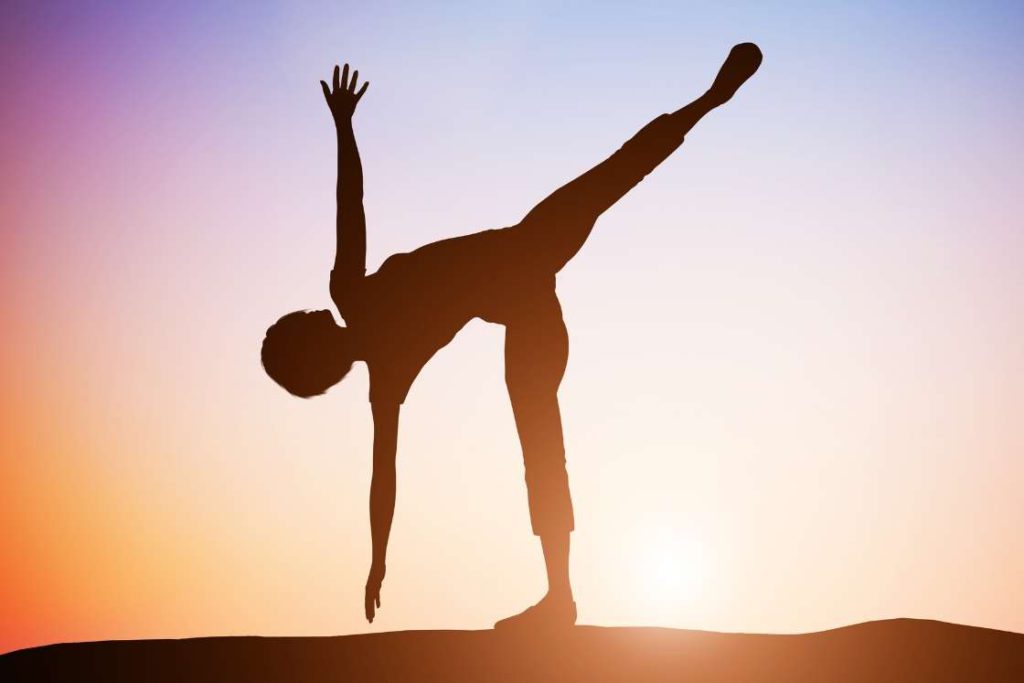
There are various health benefits of regular practice regarding Chandra Namaskara. Following are some of the leading outcomes bettering life for ages.
1. Boosts Immune system
The immune system is a by-product of various biological activities working simultaneously, Which determines the health and wellness of the practitioner.
Chandra Namaskara restores the profoundness of those activities occurring at the cellular level. Hence, regular practice strengthens the Immune system in the long run.
2. Improves Blood Circulation
Chandra Namaskara is a 14 consecutive continuous phase of asanas, which involves muscular working, and to fuel them up a regular supply of oxygen and nutrients is required. Such an unbreakable supplying chain can be only possible with the help of good blood circulation.
3. Makes Spine Flexible
Various asanas in Chandra namaskar sequence like Ashwa sanchalasana, Ardha Chandrasana, and Bhujangasana requires spinal arching. Regular practice of this salutation series results in increment in the movement ranges between the spinal columns. Hence, makes the spine flexible.
4. Develops Musculoskeletal Strength
Chandra Namaskara involves continuous efforts and coordination of various muscular muscles. On regular practice, it helps acquire a strong and aesthetically improved sculpture (thigh muscles, calves, pelvis, and ankles, mainly the lower body). However, stress on bones during practice makes them absorb more calcium from the blood and makes them solid.
5. Improves Digestion
The forward bending and backward arching in Chandra namaskar insert a wavy movement loaded with contractions and relaxation in the abdominal region. This further brings a massaging effect on the digestive organs residing in the abdominal cavity, which further restores their functioning. So, in this way, the regular practice of Chandra Namaskar improves Digestive Processes.
6. Overcome Aggression in Adolescents
This is the transitioning age in the life of an individual, where they face various changes from the outer body to the inner body. These changes sometimes create a void in the mentality, which results in irritation and aggression.
Chandra Namaskara practice soothes the mind and body by establishing a cooling effect over the practitioner. This further helps in overcoming aggression [efn_note] Monitoring Aggression In Adolescents: Chandra Namaskara As A Panacea https://www.ejerm.com/vol4_dec_2017/img/pdf/4.Monitoring-Aggression-In-Adolescents-Chandra-Namaskara-As%20-A%20-Panacea.pdf [/efn_note] in Adolescents.
7. Stimulates Endocrines Glands
The asanas in the Chandra Namaskar also act on some of the specific Positions in the body like Bhujangasana on the Thyroid Gland, Ashwa sanchalanasana on gonads and adrenal glands, Padahastasana on Pancreas, adrenal, pituitary, etc. This further regulates various metabolic activities in the body.
8. Manages Stress and Anxiety
Regular practice of Chandra Namaskara promotes deep relaxation in the practitioner, which gives a soothing effect to the Nervous system. This brings a positive approach towards the stimuli responsible for initiating stress and anxiety [efn_note] Role of yoga and meditation in sustainability and maintaining healthy life in pandemic http://www.journayu.in/downloadpdf.asp?issn=2321-0435;year=2020;volume=14;issue=4;spage=147;epage=151;aulast=Sharma;type=2 [/efn_note]. Moreover, enhanced blood circulation delivers ample oxygen to energize the brain as well.
9. Stimulates Chakras
The sequences in this salutation practices with right breathing can result in stimulation of meeting points of subtle energy channels or Chakras like Solar plexus (Manipura Chakra), Heart Chakra (Anahata Chakra), Sacral Chakra (Swadishthana Chakra), Root Chakra (Muladhara Chakra), etc. The combined effect of these chakras fills the practitioner with new life and vitality.
10. Develops Respiratory Capacity
Body in the practice of Chandra Namaskara keeps itself in a continuous working condition for a specific time period until the 14 asanas being accomplished. So, a non-stop oxygen supply is essential to run the respiration process in the muscles giving energy for all the asanas. This makes the lungs work harder and ultimately enhances the respiratory capacity in the long run.





This is not Chandra Namaskar.
There are several options. This is one of the options.